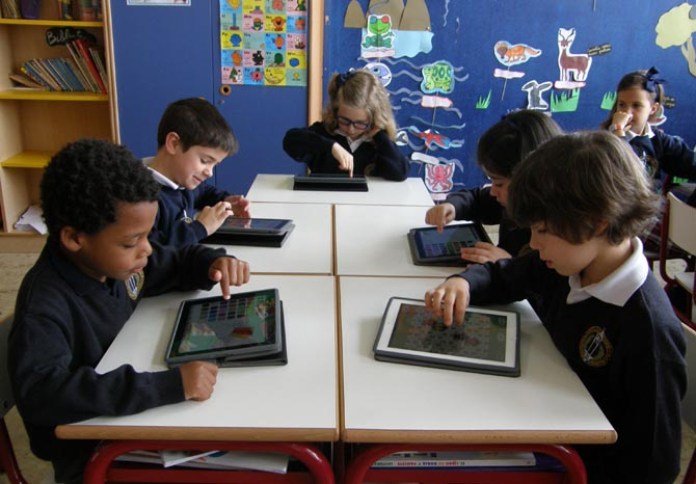EDTECH – HOW TECHNOLOGY WILL SHAPE THE FUTURE OF EDUCATION?
The role of classroom education has shifted in recent years. The focus has moved away from memorizing textbooks for learning critical thinking, collaboration and digital literacy.
What does Edtech mean?
Edtech is the abbreviation of “Educational technology”. In Educational Technology, the term “Edtech” has two definitions which are relevant to the way we use it. Edtech as an academic discipline: people study, analyze and solve problems related to teaching, learning and social organization from a technological perspective.
Edtech as a practice: any form of teaching or learning which makes use of technology. In other words, the use of technological apps, tools or services to improve learning. This definition is the one that is the most widely used in the education sector and the one we refer to in this article.

Advantages of educational technology
Modern educational technology, empowered by Artificial Intelligence, cloud, machine learning, virtual reality and big data has immense potential to digitally transform the education sector.
Edtech is not a substitute for the work of teachers and educators. Quite the opposite. With Edtech, teachers have more tools for employing strategies which focus on the use of the resources and information available.
The use of multimedia to impart knowledge. While certainly part of it, defining Edtech as using videos alone is a very limited way of looking at things. It’s like saying that maths is no more than additions and subtractions.

How technology will shape the future of education through blended learning?
1. Interactive Learning
With the deteriorating teacher to student ratio leading to more workload for teachers and only a simple blackboard and projector at the teacher’s disposal, generating curiosity for learning among students is often a difficult task.
But by using the right digital tools, we can take learning to the next level; from the lifeless papers of textbooks to engaging experience a of virtual reality and simulation programs; from instruction based learning to gamification of study modules to foster better engagement.
Also, research shows that VR is more memorable than learning through texts and videos and helps in developing cognitive and psychomotor skills.
These tools also encourage to the development of real life skills such as problem solving and decision making ability of children as they learn how to analyze different options through digital simulations without running real life risks.
2. Efficient Formative Assessment
Where the traditional teaching model leaves us with test scores and attendance percentage as a student’s only measurable information; Technology (if applied correctly) can provide us with valuable information about a student’s reading efficiency, ability to conceptualize a material, time taken to answer each questions and auto-generated reports that compare their progress over time.
Also, at the end of the day, students need to have more insights than simple grades to understand and improves their performance. Thus, making the entire assessment process more efficient than humanly possible.
3. Personalized Learning
AI-s can play a great role in competency-based adaptive learning. It can automate the e-learning feed, create recommendations based on individual learning history and in fact help students to choose a future career based on data regarding their learning ability of various subjects.
At the same time, upon analyzing student’s data, teachers can set the curriculum to match each student’s capability and pace of learning. Thus, making the once far-fetched dream of personalized learning possibilities.
4. On-demand Learning
Thanks to on-demand learning through videos, online classes and ubiquitous accessibility, students are now not bound to rush through topics in fear of being left behind. They can now repeat any lesson whenever they want. It has given the flexibility to the students who miss a physical class due to sickness or personal reasons, to catch up with the school work without any hassle. E-books and cloud have made globalized learning through collaboration easier today despite physical distance.
Also, any student in any part of the world can be provided with world-class learning facilities and guidance from experienced teachers through online classes and digital study materials, thus truly enabling learning for all.
5. Role of Teachers In The Classroom
The one attribute of 21st-century education that separates it significantly from earlier models of teaching is a philosophical shift in the role of a teacher in a classroom. If we wish to create an interactive environment, reverse the classroom design to make it more student-centric and opt for advanced digital solutions to find information; teacher’s role in the classroom has to shift from being the sole source of knowledge to be the Guide on the Side.
Tools like AI-s, metrics, content management systems not only leave the teachers with more time to focus on improving the quality of learning experience of students but also empower them with valuable insights to improve students performance based on real-time data.
6. Role Of Students
In addition to teachers, classroom technology has altered the role of the students as well. In conventional classrooms, students were passive learners and learned through listening and memorizing. But with the free access to boundless information, memorization doesn’t help students to get ahead in life. They are asked to cultivate a mindset of life-long learning.
Also, having access to information is not sufficient, students are now required to learn to connect the dots and be able to eliminate the misinformation from the essentials. Thus, students are now expected to take the driver’s seat in learning and engage actively in the process.
In the end, we must remember that technology is just a tool to enhance performance. The role of dedicated and caring teachers cannot be filled in by artificial intelligence.
At the same time, learning can definitely be made more interactive and interesting for students with the right use of technology, but we must also understand that longer screen time alone will never be sufficient to ensure better learning. It needs to be supplemented by the enthusiasm and a passion for learning among students.


 July 27, 2022
July 27, 2022 


